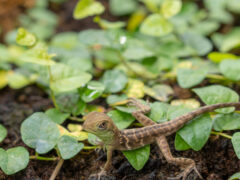Hungary’s first zoo outside the capital is proud to share a rare phenomenon and yet another major breeding success, as a total of three Asian water dragons hatched on January 23 behind the scenes in its Palm House even though both of the adults housed there are female! Since the one that ended up laying viable eggs was transferred to Debrecen in 2019 at a young age well before reaching maturity, it is highly unlikely that she had bred with a male earlier, thus leaving parthenogenesis as the only reasonable possibility. For confirmation, the mother and offspring will undergo genetic analysis.
A phenomenon most common in invertebrates but also observed in certain fish, amphibians, reptiles and birds, parthenogenesis occurs when an embryo starts to develop from an unfertilized egg cell, with no contribution from a male. The only other documented case of successful breeding in Asian water dragons via parthenogenesis is from a couple years ago, with a single offspring to a female in Smithsonian’s National Zoo in the USA.
Native to forests near water throughout the Far East, Asian water dragons (Physignathus cocincinus) are a diurnal arboreal species with excellent swimming skills and the ability to stay underwater for up to 25 minutes. They mostly feed on insects, fish, smaller mammals and reptiles, but also forage for plant parts. Like many of their cousins, including other dragon lizards as well as iguanas and monitor lizards, they have a pineal eye, a photosensitive spot on top of their head that helps them find optimal basking spots. Due to their impressive looks and relatively docile nature, they are a popular terrarium species worldwide, although their populations in the wild are threatened by habitat loss and illegal captures for trade – hence their listing as Vulnerable in the International Union for the Conservation of Nature’s Red List.
Dr. Gergely Sándor Nagy
CEO, Debrecen Zoo and Amusement Park




















